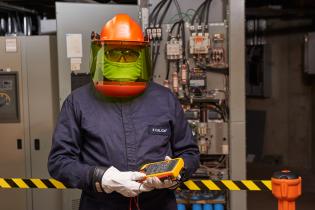Avoiding arc flash
Arc flash vs arc blast
Arc flash vs arc blast. When an arc fault occurs, the result is a massive electrical explosion. The light and heat emitted by the explosion is known as the arc flash, and the pressure wave is known as the arc blast.
Arc flash protection with thermal imaging
Understand what the NFPA 70E standards for arc flash PPE assessment means for thermographers using thermal imaging camera.
Understanding the arc flash boundary
The arc flash boundary is the minimum “safe” distance from exposed energized conductors or circuit parts that has the potential for an arc flash. The required arc-rated clothing and PPE increases rapidly as a worker approaches the potential source of an arc flash
Top 5 safety tools for preventing arc flash
Limiting workers’ exposure to electrical hazards like arc flash or electrocution is a solid foundation for any electrical safety program. Combine that mindset with the right non-contact tools and more electrical workers will be kept out of harm’s way.
